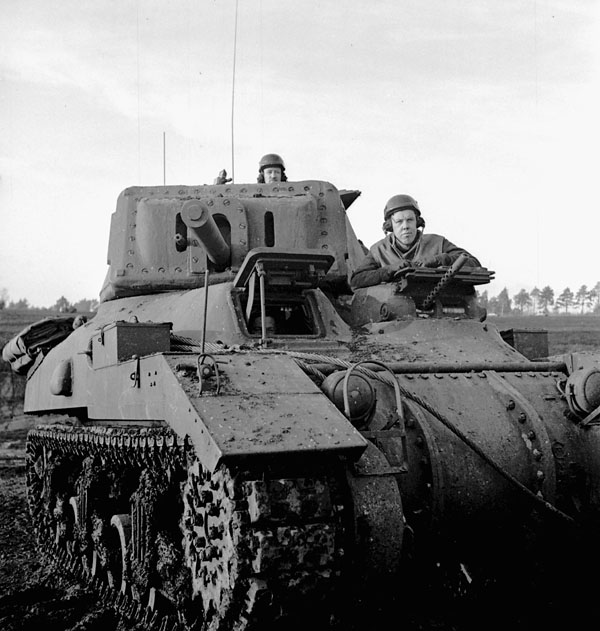The Ram was a Canadian cruiser tank produced during the Second World War (WWII) to overcome the lack of tanks in Canada. This Canadian tank used a modified version of the US M3 tank chassis, with the addition of a turret that could accommodate a 40 mm anti-tank gun in the initial design and a 57 mm gun from 1942 on. From 1941 to 1943, the Montreal Locomotive Works produced about 1,949 Ram tanks. Because of the availability of other, more modern tanks, the Ram never saw combat, but its design served as the basis for variants such as the Kangaroo armoured personnel carrier and the Sexton self-propelled gun. The Ram and its variants are the only tanks ever designed and built in Canada. (See also Armaments.)

Origins
In 1940, the British army suffered a major defeat at the hands of the German forces invading France. (See Second World War (WWII).) British troops were evacuated from the port of Dunkirk, but had to abandon most of their heavy equipment, including their tanks. British industry had to make up this loss and called on the Canadian army, among others, to produce combat vehicles. At the time, Canada was not manufacturing any tanks domestically and had trouble in purchasing tanks from the United States, because the British had also placed orders with them. The plans to build a Canadian tank, which had been made before the Battle of Dunkirk, could now be carried out.
The Canadian federal government ordered the Canadian Pacific Railway to produce British Valentine tanks. The Canadian authorities were also thinking about manufacturing the new US M3 Medium Tank, which had an impressive armament for the time, with its 75 mm main gun. But the M3 also had a tall silhouette that made it easy to see and hence vulnerable to enemy fire. In addition, its 75 mm gun was mounted on the hull, which limited its use, because the crew had to turn the entire tank to aim the gun. These shortcomings encouraged the Canadians to develop of a new tank derived from the M3.
Did you know?
The British named their American tanks after generals from the US Civil War. Thus they named the M3 Medium Tank after General Lee, the modified British version of the M3 after General Grant, and the M4 after General Sherman.
Development
Instead of producing M3 tanks, Canada finalized the design of a modified version of the US M3 in March 1941. The Canadian tank retained the chassis and many mechanical parts from the M3. To reduce the vehicle’s size, the 75 mm gun was removed from the hull. Reflecting British influences, the driver’s seat was moved to the right-hand side of the tank. A secondary, machine-gun turret was added at the bow.
Added to the Canadian design was a larger main turret that could traverse 360 degrees and could mount the British army’s standard anti-tank gun, the 40 mm two-pounder. But this gun was too weak to pierce the latest German armoured vehicles. For this reason, the Ram was updated later in 1941. But its turret was too small to practically accommodate a gun as big as the American 75 mm, so the 57 mm six-pounder gun was installed instead. Armed with this gun, the tank was renamed the Ram Mk II. The gun on the Ram Mk II differed from most tanks then in use by virtue of its stabilizer, which made it easier to fire in motion.
Compared with the earlier model, the Ram Mk II incorporated several improvements that solved various mechanical problems and simplified production. For example, the machine-gun turret was eliminated from the last version of the Mk II that was produced.
Production
Responsibility for assembling the Ram was given to the Montreal Locomotive Works company. Several major components, such as the engine and transmission, were made in the United States. These parts were sent to Montreal to be assembled. The prototype was completed in June 1941, and a ceremony was held to celebrate this achievement, with Minister of Munitions and Supply C.D. Howe and many media representatives in attendance. (See Department of Munitions and Supply.)

In early 1942, the first Ram Mark II tanks rolled off the assembly line at the Montreal Locomotive Works. In total, 50 Ram Mk I and 1899 Ram Mk II tanks were produced from 1941 to 1943.
Use
Many Ram tanks were shipped to the United Kingdom, where Canadian troops were waiting to invade Western Europe. (See Second World War (World War II).) The Ram was used mainly as a training tank for the new Canadian armoured divisions.
To simplify production and distribution logistics, the Allied commanders wanted to standardize the equipment to be used by the Canadian troops and their British and American allies in the invasion. In July 1942, the decision was therefore made to gradually replace the Ram with the M4 Medium (Sherman) Tank. This American tank had the same 75 mm gun as the M3, which was more versatile than the six-pounder on the Ram Mk II. Compared with the Canadian tank, the M4 was also easier to fit with new kinds of armament, including larger guns such as the 76 mm and the 17 pounder.
Variants: Sexton, Ram OP and Kangaroo
Many Rams were modified for other purposes. The production of Rams was adapted to manufacture the Sexton self-propelled gun, an artillery vehicle consisting of a 25-pound gun open-mounted on the Ram hull. Other Rams were converted into mobile command posts (Ram OPs) for the Sexton units. The best known variant of the Ram is probably the Ram Kangaroo, a turretless Ram that enabled soldiers to be sheltered from enemy fire while remaining mobile. Unlike the Ram tank itself, all of these variants were actually used in combat.

 Share on Facebook
Share on Facebook Share on X
Share on X Share by Email
Share by Email Share on Google Classroom
Share on Google Classroom







